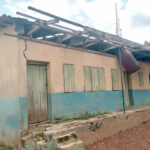Young people living in Nigeria are among those most at risk of the impacts of climate change, threatening their health, education and protection.
According to a UNICEF report, Nigeria ranked second in terms of risks that climate change poses to children out of 163 countries in the world.
When Nigerian Tribune interacted with children in secondary schools in Life camp area and Kubwa of the Federal Capital Territory (FCT) in Abuja, a good number of them aged 11 to 16 seemed to be ignorant or lacked ideas of what climate change is or actions to mitigate it.
A male student of a secondary school in Jabi 1 Jabi District of Abuja, who is in Junior Secondary School class (JSS 2), said he has not even heard of or thought about climate change.
“No curriculum or scheme of work in our school has ever included climate change or climate action since I’ve been attending this school,” he said.
The response was not different from his female counterpart who is a Senior Secondary Student (SS 2) student at a government owned senior secondary school also in Jabi District in Abuja. “Will climate change be a topic or subject that will be added to our school curriculum any time soon?” she asked.
The response was a bit different in Kubwa, Bwari Area Council, as two students of SS2, also in a government-owned senior secondary school said they had heard about climate change and its impact on television.
According to an expert in environmental study who craved anonymity, many parents or guardians lack adequate information or knowledge to teach their children about climate change and the risks it poses to children, humans and the planet in general.
According to a UNICEF report launched in collaboration with Fridays for Future on the third anniversary of the youth-led global climate strike movement, approximately one billion children, nearly half the world’s 2.2 billion children, live in one of the 33 countries classified as “extremely high-risk.”
The Children’s Climate Risk Index is the first comprehensive analysis of climate risk from a child’s perspective.
It ranks countries based on children’s exposure to climate and environmental shocks, such as cyclones and heat waves, as well as their vulnerability to those shocks, based on their access to essential services.
The findings reflect the number of children impacted today; figures therein indicate that it is likely to get worse as the impacts of climate change accelerate.
Children in Nigeria at ‘extremely high risk’ of impacts of climate crisis
Nigeria is ranked second among these countries, together with Chad, and just behind the Central African Republic (ranked first).
The report found that Nigerian children are highly exposed to air pollution and coastal floods, but also that investments in social services, particularly child health, nutrition and education can make a significant difference in the country’s ability to safeguard the future of children from the impacts of climate change.
The UNICEF Nigeria Representative, Peter Hawkins, said “The climate crisis is a child’s rights crisis,” stressing that “Nigeria is not immune to the effects of climate change, but we can act now to prevent it from becoming worse.
“We need to invest in the services children depend on to survive and thrive – such as water, healthcare and education – to protect their futures from the impacts of a changing climate and degrading environment.”
Global ‘Children’s Climate Risk Index’ (CCRI)
The CCRI findings revealed that 240 million children are highly exposed to coastal flooding; while 330 million children globally are highly exposed to riverine flooding.
It added that 400 million children are highly exposed to cyclones; 600 million children are highly exposed to vector borne diseases even as 815 million children are highly exposed to lead pollution.
The findings further showed that about 820 million children are highly exposed to heat waves and 920 million children are highly exposed to water scarcity.
Meanwhile, one billion children are highly exposed to exceedingly high levels of air pollution.
An estimated 850 million children – one in three worldwide – live in areas where at least four of these climate and environmental shocks overlap. As many as 330 million children – one in seven worldwide – live in areas affected by at least five major shocks.
The report also revealed a disconnect between where greenhouse gas emissions are generated, and where children are enduring the most significant climate-driven impacts.
The 33 extremely high-risk countries – including Nigeria – collectively emit just 9 per cent of global CO2 emissions. Conversely, the 10 highest emitting countries collectively account for nearly 70 per cent of global emissions. Only one of these countries is ranked as ‘extremely high-risk’ in the index.
“The frightening environmental changes we are seeing across the planet are being driven by a few but experienced by many,” said Peter Hawkins.
“Children know climate change is a threat to their future, and they are calling on world leaders to act. So far, too little has been done, but we still have time. We must urgently reduce greenhouse gas emissions and work as a global community to build a better world for all children.”
Without the urgent action required to reduce greenhouse gas emissions, children will continue to suffer the most. Compared to adults, children require more food and water per unit of their body weight. Therefore they are less able to survive extreme weather events, and are more susceptible to toxic chemicals, temperature changes and diseases, among other factors.
Calling governments, businesses, relevant stakeholders to action
UNICEF recommended increased investment in climate adaptation and resilience in key services for children. To protect children, communities and the most vulnerable from the worst impacts of the already changing climate, critical services must be adapted, including water, sanitation and hygiene systems, health and education services.
“Reduce greenhouse gas emissions. To avert the worst impacts of the climate crisis, comprehensive and urgent action is required. Countries must cut their emissions by at least 45 per cent (compared to 2010 levels) by 2030 to keep warming to no more than 1.5 degrees Celsius.
UNICEF also advised government to “provide children with climate education and greens skills, critical for their adaptation to and preparation for the effects of climate change. Children and young people will face the full devastating consequences of the climate crisis and water insecurity, yet they are the least responsible. We have a duty to all young people and future generations.”
It added that government must strive to “include young people in all national, regional and international climate negotiations and decisions, including at COP. Children and young people must be included in all climate-related decision making.”
READ ALSO FROM NIGERIAN TRIBUNE
WATCH TOP VIDEOS FROM NIGERIAN TRIBUNE TV
- Let’s Talk About SELF-AWARENESS
- Is Your Confidence Mistaken for Pride? Let’s talk about it
- Is Etiquette About Perfection…Or Just Not Being Rude?
- Top Psychologist Reveal 3 Signs You’re Struggling With Imposter Syndrome
- Do You Pick Up Work-Related Calls at Midnight or Never? Let’s Talk About Boundaries







